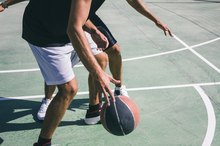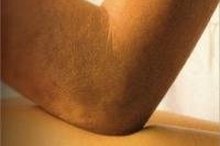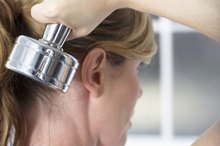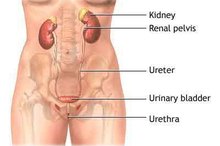Injury to a Forearm Muscle
The majority of injuries that happen to forearm muscles are a result of overuse, according to the Sports Injury Handbook. Continual wear and tear on the muscles, ligaments and nerves eventually leads to a breakdown of the tissues and injury when you perform the activity that caused the weakness. Injuries also can occur from sudden, forceful pulls or force on the muscles. Falls and other accidents account for additional injuries.
Symptoms
When a forearm muscle is pulled or strained, you will feel a sudden, severe pain in the area. When the force is strong enough, you may tear one of the muscles and hear a slight pop associated with the excruciating pain. Forearm muscles can become inflamed from overuse, as in the case of tennis elbow, and cause swelling and restricted movements. The pain often radiates up to the elbow, which his why many athletes attribute the pain to an elbow injury.
- When a forearm muscle is pulled or strained, you will feel a sudden, severe pain in the area.
Treatments
Torn Tendons & Ligaments From Hyperextension
Learn More
Rest and ice compresses usually are prescribed to alleviate the swelling of strained or torn muscles in the forearm. The pain of a pulled muscle usually subsides in a couple days when ice is applied frequently for up to 20 minutes at a time. Sprained and torn muscles must be rested to allow them time to heal. Over-the-counter anti-inflammatory medications such as aspirin or ibuprofen can reduce swelling, while cortisone shots may be used to relieve the pain that often emanates in the joints of the elbow.
- Rest and ice compresses usually are prescribed to alleviate the swelling of strained or torn muscles in the forearm.
Prevention
Proper form when lifting weights or playing sports is vital to prevent injuries to the forearm muscles. Learning how to hold a tennis racket properly and turn the body to meet the ball can prevent the forearm muscles from extending unnaturally. Overuse is reduced when the rest of the body takes up some of the motion to hit a ball or swing a golf club. Leg muscles and strong abdominal muscles can help to prevent forearm strains while lifting weights. Ideally, the weight should be spread among a variety of muscles so that excessive pressure isn't placed on one set of muscles. According to the University of Pittsburgh Medical School, exercising in cold weather also can lead to muscle strains in the forearms.
- Proper form when lifting weights or playing sports is vital to prevent injuries to the forearm muscles.
- According to the University of Pittsburgh Medical School, exercising in cold weather also can lead to muscle strains in the forearms.
Preparation
Right Elbow Pain When Playing Golf
Learn More
Athletes should prepare for their activities with stretching and warm-ups to get the muscles ready for the pressure of the sport. Warm-ups typically are aerobic in nature and can include swinging your arms while running on a treadmill or riding an elliptical trainer for 10 or 15 minutes utilizing the handles to move your arms. Stretching is vital both before and after exercising to keep muscles flexible. Strengthening the muscles in the forearms also can lead to fewer forearm injuries. Exercises that target forearm muscles include wrist curls performed while holding free weights and squeezing a tennis ball.
- Athletes should prepare for their activities with stretching and warm-ups to get the muscles ready for the pressure of the sport.
- Exercises that target forearm muscles include wrist curls performed while holding free weights and squeezing a tennis ball.
Related Articles
References
- University of Pittsburgh Medical School: Forearm Muscle Strain
- Sports Injury Clinic: Inflammation of the Tendons and Muscles of the Forearm
- Sports Injury Handbook: Top 10 Sports Injuries
- Vaquero-picado A, Barco R, Antuña SA. Lateral epicondylitis of the elbow. EFORT Open Rev. 2016;1(11):391-397. doi:10.1302/2058-5241.1.000049
- Amin NH, Kumar NS, Schickendantz MS. Medial epicondylitis: evaluation and management. J Am Acad Orthop Surg. 2015;23(6):348-55. doi:10.5435/JAAOS-D-14-00145
- Blackwell JR, Hay BA, Bolt AM, Hay SM. Olecranon bursitis: a systematic overview. Shoulder Elbow. 2014;6(3):182-90. doi:10.1177/1758573214532787
- Truong J, Ashurst JV. Septic Bursitis. Treasure Island, Fl: StatPearls Publishing; 2019.
- Varacallo M, Mair SD. Proximal Biceps Tendinitis and Tendinopathy. Treasure Island, Fl: StatPearls Publishing; 2019.
- Bellapianta JM, Lavelle WF, Lavelle ED, Onyedika I, Economedes D, Whipple R. Hand Pain. Current Therapy in Pain. 2009:156-167. doi:10.1016/b978-1-4160-4836-7.00021-3
- Moradi A, Ebrahimzadeh MH, Jupiter JB. Radial Tunnel Syndrome, Diagnostic and Treatment Dilemma. Arch Bone Jt Surg. 2015;3(3):156-62.
- Saeed W, Waseem M. Elbow Fractures Overview. Treasure Island, Fl: StatPearls Publishing; 2019.
- Athwal GS. Elbow Dislocation - OrthoInfo - AAOS. OrthoInfo: American Academy of Orthopaedic Surgeons. Oct 2017.
- Bursitis. MedlinePlus. Sept 12, 2019.
- Harvard Health Publishing. The importance of stretching. Harvard Health. Sept 2013.
- Tennis Elbow (Lateral Epicondylitis) - OrthoInfo - AAOS. OrthoInfo: American Academy of Orthopaedic Surgeons. Jul 2015.
- Shah CM, Calfee RP, Gelberman RH, Goldfarb CA. Outcomes of rigid night splinting and activity modification in the treatment of cubital tunnel syndrome. J Hand Surg Am. 2013;38(6):1125-1130.e1. doi:10.1016/j.jhsa.2013.02.039
- Biceps Tendinitis - OrthoInfo - AAOS. OrthoInfo: American Academy of Orthopaedic Surgeons. Feb 2016.
- Kinaci A, Neuhaus V, Ring D. Surgical procedures of the elbow: a nationwide cross-sectional observational study in the United States. Arch Bone Jt Surg. 2015;3(1):13-8.
- American Academy of Orthopedic Surgeons. (n.d.). Elbow Arthroscopy.
- Kane SF. Evaluation of Elbow Pain in Adults. Am Fam Physician. 2014 Apr 15;89(8):649-57.
- O'Connor FG. (2018). Evaluation of elbow pain in adults. Fields KB, ed. UpToDate. Waltham, MA: UpToDate Inc.
- Sources:American Academy of Orthopedic Surgeons (n.d.). Elbow Fractures in Children.
Resources
Writer Bio
Linda Ray is an award-winning journalist with more than 20 years reporting experience. She's covered business for newspapers and magazines, including the "Greenville News," "Success Magazine" and "American City Business Journals." Ray holds a journalism degree and teaches writing, career development and an FDIC course called "Money Smart."









